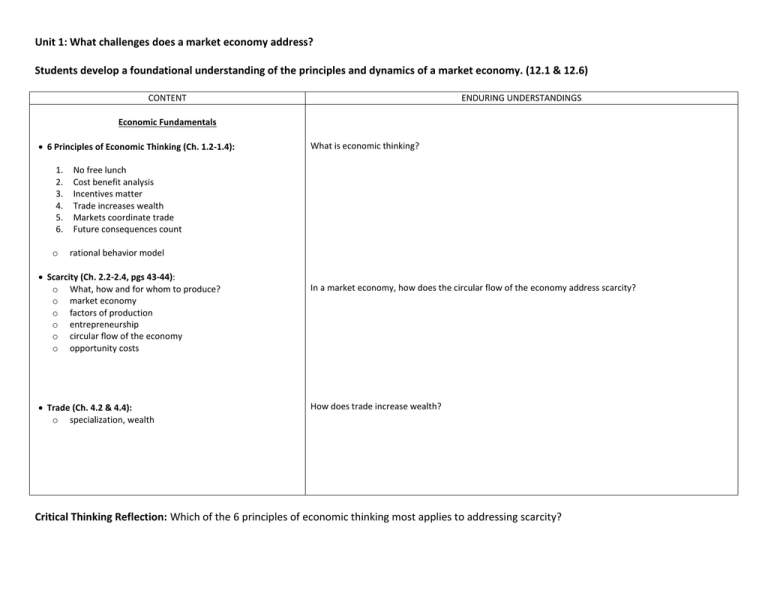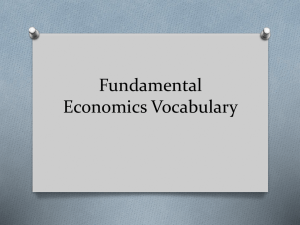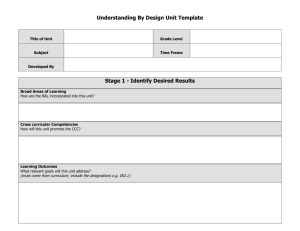Econ Content Rubrics 13
advertisement

Unit 1: What challenges does a market economy address? Students develop a foundational understanding of the principles and dynamics of a market economy. (12.1 & 12.6) CONTENT ENDURING UNDERSTANDINGS Economic Fundamentals 6 Principles of Economic Thinking (Ch. 1.2-1.4): 1. 2. 3. 4. 5. 6. o What is economic thinking? No free lunch Cost benefit analysis Incentives matter Trade increases wealth Markets coordinate trade Future consequences count rational behavior model Scarcity (Ch. 2.2-2.4, pgs 43-44): o What, how and for whom to produce? o market economy o factors of production o entrepreneurship o circular flow of the economy o opportunity costs Trade (Ch. 4.2 & 4.4): o specialization, wealth In a market economy, how does the circular flow of the economy address scarcity? How does trade increase wealth? Critical Thinking Reflection: Which of the 6 principles of economic thinking most applies to addressing scarcity? $ Income from sale of factors (gross and net) $ Payments for factors Factor Markets Factors of Production: Land, Labor, Capital Factors of Production: Land, Labor, Capital Businesses/ Firms/ Producers/ Suppliers Individuals/ Consumers/ Households Goods & Services Goods & Services Product Markets $ Consumer Spending $ Profit from sale of goods and services (gross and net) Unit 2: What makes a market economy work? Students analyze the relationship between demand and supply and the role of banking and savings in a market economy. (12.2) CONTENT ENDURING UNDERSTANDINGS Demand, Supply and Price 2.1 Demand (Ch. 5.2-5.3 & 5.6): o demand curve o law of demand o change in quantity demanded vs. change in demand o demand shifter (determinants) o demand elasticity Supply (Ch. 5.4-5.5 & 5.7): o supply curve o law of supply o change in quantity supplied vs. change in supply o supply shifters (determinants) Price (Ch. 6.2-6.6 & 2.2): o interaction of supply and demand o market equilibrium o shortages and surpluses o price ceilings and price floors Select any product and graph a demand curve for the product and explain and graph changes in quantity demanded. Graph and explain changes in demand with specific reference to demand shifters (determinants). Graph and explain demand elasticity. Select any product and graph a supply curve for the product and explain and graph changes in quantity supplied. Graph and explain changes in supply with specific reference to supply shifters (determinants). Explain supply elasticity. As a form of incentive, how do prices help markets coordinate trade? What is the purpose of price ceilings and price floors? How do they sometimes produce unintended consequences? Banking, Saving and Investing 2.2 Money and Financial Institutions (Ch. 8.2-8.3): o functions of money o currency o assets o liquidity o loans and bank reserves Individual deposits contribute to the circular flow of the economy. How are deposits an example of the ‘future consequences count’ principle? Personal Savings and Investment (Ch. 8.3-8.5, 9.5): o interest rates o stocks and bonds o corporations: limited liability o consumer credit and debt o diversification o funding retirement Since future consequences count, what habits should you develop when you save? invest? incur debt ? Unit 3: What do markets fail at? Students analyze markets, failures, and regulations in a market economy. (12.2, 12.4) CONTENT ENDURING UNDERSTANDINGS Markets, Failures and Regulations Market Structures (Ch. 7.2 -7.5): o perfect competition o monopoly o oligopoly o monopolistic competition Given the economic principle of ‘trade increases wealth’, when is a monopoly an appropriate way to structure a market? Market Failures (Ch. 7.6, 11.4) o externalities o public goods What is the connection between public goods and the economic principle that ‘incentives matter’? Labor Market (Ch. 10.2-10.3 & 10.5): o outsourcing and offshoring o human capital: education and skills o salary and wages, benefits o unions In a market economy, why do labor unions exist? Regulating Markets (Ch. 11.3-11.4, 7.6): o regulatory agencies o deregulation Since the circular flow of the economy ‘coordinates trade’, why does government regulation exist? Critical Thinking Reflection: Choose a specific market and analyze successes and failures. For example: labor market, specific product market, stock market, on-line market, bond market, currency market, or any other market approved by your teacher. Unit 4: What is the proper role of government in a market economy? Students analyze the role of government in measuring and managing the growth of the U.S. economy. (12.3 & 12.5) CONTENT ENDURING UNDERSTANDINGS Alternatives to a Market Economy 4.1 Alternative Economic Systems (Ch. 3.3): o traditional o command Which of the six economic principles do not play a role in a command economy? Mixed Economies (Ch. 3.4-3.5): o mixed market o U.S. capitalism and it’s characteristics Why is government intervention in the economy necessary in order to fulfill the six economic principles? Measuring the Economy 4.2 Measuring the Economy (Ch. 13.2-13.5): o GDP o inflation o unemployment o business cycle: recession, depression Why does the government measure inflation in the circular flow of the economy? Why does the government measure unemployment in the circular flow of the economy? What role does the government play in the business cycle? Managing the Economy 4.3 Monetary Policy (Ch. 14.4, Ch. 8.3 pg. 149-150): o Federal Reserve o loans and the money supply o tight money policy o easy money policy Under what circumstances should the Federal Reserve engage in tight money policy or easy money policy? Fiscal Policy (Ch. 12.2-12.4): o legislative and executive branches o taxes o budget priorities o entitlements o discretionary spending, What role does fiscal policy play in the circular flow of the economy? Supply Side and Demand Side Economics (Ch. 14.2-14.3 & 14.5): o expansionary and contractionary policy o automatic stabilizers o debt and deficit spending What are the limits of monetary policy and fiscal policy in encouraging economic growth? Critical Thinking Reflection: What are the responsibilities, if any, of consumers, producers, financial institutions and the government in ensuring economic justice in the U.S.? Key Term Map for: ____________________________ 1. Definition 2. Examples and opposites ≠ 3. Related course principles 4. Symbolic graphic, specific current application, multiple perspectives, convergence, paradox, contribution, interdisciplinary connection Box #1 – Definition: Use any of the following to help create the definition: the glossary at the end of the textbook, the “Speaking of Economics” section at the beginning of each chapter, the related section in the textbook, and/or guided reading and note-taking packet Box #2 – Examples and opposites ≠: List examples from previous units, your historical study, current events or hypotheticals. Also list example(s) that are opposite or is in contrast to the key term, and tag all opposites with the ≠ symbol. Box #3 – Related course principles: List the economic thinking principles that are most closely related to the key term. Box #4 – Choose one or more of the following: symbolic graphic: draw a picture that is a metaphorical representation of the key term specific current application: identify and explain a current event that exemplifies the key term multiple perspectives: explain an alternative or opposing point of view convergence: identify how the key term merges or interrelates with another term paradox: explain inconsistencies or contradictions that are associated with this key term contribution: explain the origin of the key term and/or identify what this term makes possible interdisciplinary connection: identify instances, analogies, or insights from other fields of study




